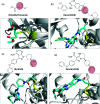Covalent inhibitors: a rational approach to drug discovery
- PMID: 33479682
- PMCID: PMC7557570
- DOI: 10.1039/d0md00154f
Covalent inhibitors: a rational approach to drug discovery
Abstract
Covalent inhibitors are recognized as an important component in drug discovery and therapeutics. Since the first appearance of covalent inhibitors in the late 18th century, the field has advanced significantly and currently about 30% of the marketed drugs are covalent inhibitors. The numerous advantages of covalent inhibitors are counteracting the initial concerns regarding potential off-target toxicity. Thus, continuous research, especially for cancer targets is reported. The aim of this review is to provide a short historic overview and focus on recently developed covalent inhibitors (2011-2019), including structural aspects and examples on challenging targets.
This journal is © The Royal Society of Chemistry 2020.
Figures













References
-
- Gehringer M., Laufer S. A. J. Med. Chem. 2018;62:5673–5724. - PubMed
-
- Singh J., Petter R. C., Baillie T. A., Whitty A. Nat. Rev. Drug Discovery. 2011;10:307–317. - PubMed
-
- Bauer R. A. Drug Discovery Today. 2015;20:1061–1073. - PubMed
-
- Shimokawa T., Smith W. J. Biol. Chem. 1992;267:12387–12392. - PubMed
-
- Waxman D. J., Strominger J. L. Annu. Rev. Biochem. 1983;52:825–869. - PubMed
Publication types
Grants and funding
LinkOut - more resources
Full Text Sources
Other Literature Sources

